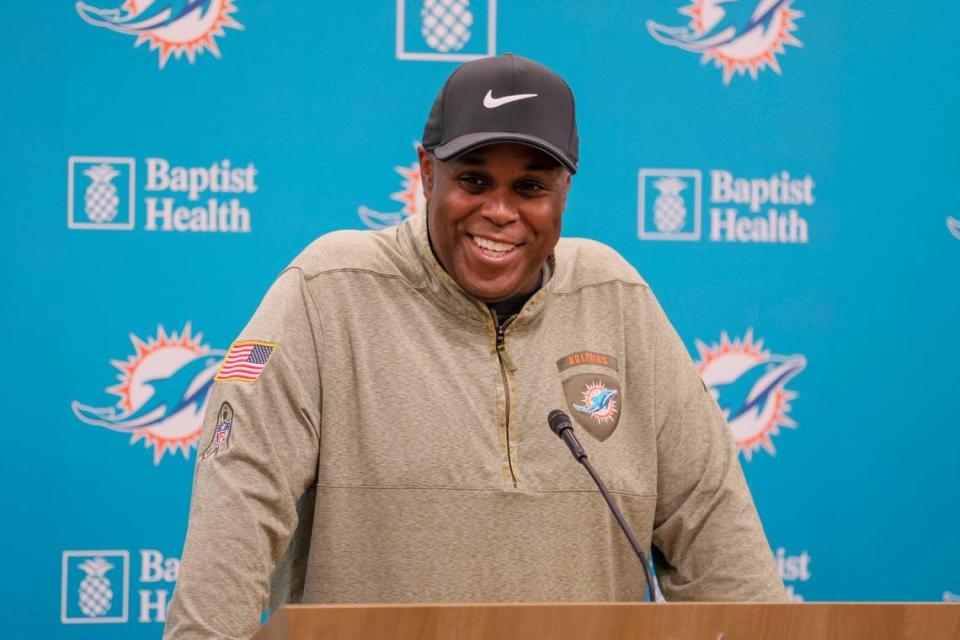Omar Kelly: Dolphins GM Chris Grier must decide between drafting now or more picks later | Opinion

Sometimes old skin needs to be shed for the body to make room for new growth.
That’s the position Miami Dolphins general manager Chris Grier finds himself in heading into this week’s NFL Draft as the franchise he has steered for the past five offseasons changes course again.
The Dolphins are embarking on yet another metamorphosis, shifting from the “[forget] them picks” era of the past two offseasons — a run that coincided with the franchise’s effort to build a Super Bowl contender — into a draft-and-develop, talent harvesting team that must replenish the roster with younger, cheaper labor as Miami prepared to carry a hefty quarterback salary.
When quarterbacks require a $40-million to $50-million-a-year salary, which is the neighborhood of what Tua Tagovailoa’s upcoming deal will put him in, the financial belt needs to tighten, and to do that effectively teams must draft and develop players well.
Miami endured a troubling, and painful exodus of talent this spring as former draftees-turned-starters such as Christian Wilkins, Robert Hunt, Andrew Van Ginkel, Raekwon Davis and Brandon Jones landed free agent deals from other teams Miami wasn’t willing to match.
Then another batch of former starters, talents such as Xavien Howard, Jerome Baker and Emmanuel Ogbah were purged to clear salary space. As a result, this offseason’s focus has been on finding their replacements, restocking the shelves.
Most roster voids have been filled through free agency courtesy of the additions such as Jordyn Brooks, Aaron Brewer, Kendall Fuller and more, but there are still glaring needs on the offensive and defensive line, and Miami would benefit from adding a top-shelf receiver, and a safety or two.
Problem is, Miami only has six selections in the 2024 NFL Draft, and only two of them (No. 21 and No. 55) are in the draft’s first 155 picks.
That’s why Grier has to give serious consideration to trading down in the first two rounds to pick up more selections if the goal is to fill more holes with rookies, who represent cheap labor for at least their first three seasons.
Draftees with upside are the most cost-effective way to restock the shelves, but it could come at a cost considering Grier feels Miami’s in position to land a prospect with a legitimate first-round grade if the Dolphins stay at 21.
“I think we’re open to everything, but also you don’t want to pass on a good player,” Grier said last week in his annual predraft news conference. “If there is someone there that we all feel very strongly about that can really impact our roster, it’s [a debate about] how far can you drop down and still possibly get him?
“You always weigh those factors of, yeah, it’s great to pick up an extra third, but if that second-round player is someone we believe in, like a Jevon Holland or Jarvis Landry in the second round, then you’ll take the player.”
Six teams traded down from pick No. 21 in the first round during the past 16 drafts, and all but one trade put the selling team in the range of a second- and third-day selections Miami’s missing because of past trades, and the NFL’s punishment for owner Steve Ross tampering with Sean Payton and Tom Brady during the 2022 offseason.
The New England Patriots moved from 21 to 29 in 2022 and received a third- and fourth-round picks in that draft from Kansas City.
In 2019 the Seattle Seahawks moved down from 21 to 30 and received from Green Bay two fourth-round selections.
Washington moved down just one spot in 2016 — going from 21 to 22 — and got a seventh-round pick from the Houston Texans, who used the pick to select receiver Will Fuller IV.
The Cincinnati Bengals moved down from 21 to 27 in the 2012 draft and got a third-round pick from the Patriots, who used the pick on pass rusher Chandler Jones.
The Chiefs moved down from 21 to 26 in 2011, securing a third-round pick from the Cleveland Browns, who took defensive tackle Phil Taylor.
And in 2008 Washington traded pick 21, along with third- and fifth-round selections to the Atlanta Falcons for two second-round picks (34th and 48th overall) and a fourth-round selection.
With that 21st pick the Falcons selected offensive tackle Sam Baker, who started 61 games for the Falcons during his six-year NFL career.
Washington ended up with receiver Devin Thomas and tight end Fred Davis with those two Dy 2 selections.
And that’s the great debate for Grier?
Is this the right draft, and the right time to pull off a two-for-one, shipping away one of Miami’s prized draft assets to acquire more selections in the later rounds?
It’s the old quantity or quality debate.
Only time, and the options left on the board in round one and two will determine that. But a new direction for the Dolphins could dictate that it’s time for Grier to take a different approach to building the roster.

